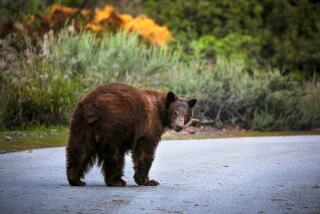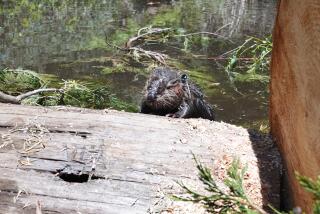Beaver Boom Considered a Dam Nuisance
- Share via
CHICAGO — Homeowners and wildlife officials are battling a booming population of beavers that snack on valuable trees and cause floods, but animal-rights groups say killing the critters could damage the environment.
As cities and suburbs expand, people and beavers are sharing the same habitat, and humans are demanding the right of way, an animal-rights spokeswoman said last week.
“We humans are so pushy and anxious about having somebody’s tree cut down that we resort to killing as our No. 1 method of solving a perceived problem,” said Mary Beth Sweetland, a researcher with Maryland-based People for the Ethical Treatment of Animals.
“We’re going to end up decimating the beaver populations and destroying the ecosystem,” she said.
Beavers are helpful because of their engineering ability. They clear old, dead trees from forests and build dams that, in turn, create ponds which are home for many aquatic plants and animals, biologists say.
Instead of killing beavers, states should try sterilization or relocation programs, Sweetland said.
But state and federal officials said beavers, which once neared extinction in the Midwest because of fur trapping, are now so plentiful that relocating them isn’t feasible.
“It’s like asking somebody to take termites out of your house and letting them go outside. That’s essentially dumping them on your neighbor,” said Bob Bluett, a biologist with the Illinois Department of Conservation.
Beavers are unpopular with landowners and homeowners because they dam important waterways, flood roads and dine on young trees, bushes and shrubs, said Gary Larson, assistant director of animal damage control at the U.S. Department of Agriculture.
Officials in at least 12 states--including Oklahoma, Texas, Alabama, Mississippi and Wisconsin--have asked for federal help in controlling the tens of millions of dollars in damage that beavers have caused, federal authorities said.
Larson said that, although the amount of money spent on beaver damage is insignificant compared to a state or national budget, the destruction can be catastrophic to an individual.
“If an orchardist located on a stream has half his trees destroyed, it can ruin him,” he said.
Larson said that the growth in the beaver population might be linked to the decline in the value of their pelts. Top price now is $20 to $28, compared to up to four times that amount only a few years ago, he said.
“States call us about damage, and we go and look at it and try to determine the best way to solve it,” he said in a telephone interview. “In many states, they simply deal with the (beaver) problem themselves.”
Illinois has been one of those states. In Libertyville, families of beavers have felled scores of trees around Butler Lake Park. Some homes in Hawthorne Woods have been flooded by drainage ditches clogged by beaver dams.
Most states have been prodded by private property owners into extending trapping seasons and drastically relaxing hunting regulations. Goodwill toward the cute rodents--which can grow to 80 pounds--has been gnawed away, officials say.
“When you have a person who has land on a lake, and the outlet on the lake is plugged up, and the lake rises and threatens their septic system, the owner can get pretty hot under the collar,” said Laine Stowell, a Wisconsin wildlife damage specialist.
Wisconsin has even put a bounty on beavers, offering $7.50 for each pelt in 1989 and $10 in 1990. About 11,000 pelts were brought in last year, out of the state’s estimated beaver population of 140,000, he said.
In Illinois, officials have advised property owners to encircle the base of trees with wire mesh, which is difficult for the beavers to gnaw through.
Minnesota, with several hundred thousand of the critters, last year spent about $3 each to kill 100,000 beavers, said Ed Boggess of the state Department of Natural Resources.
More to Read
Sign up for Essential California
The most important California stories and recommendations in your inbox every morning.
You may occasionally receive promotional content from the Los Angeles Times.










